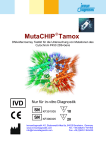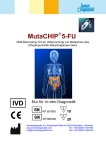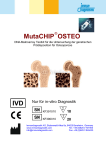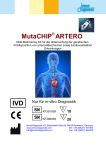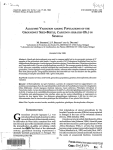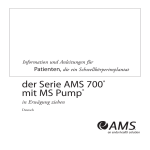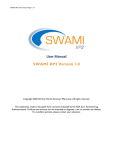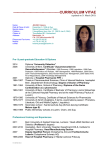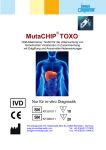Download MutaCHIP FOOD - bei Immundiagnostik
Transcript
® MutaCHIP FOOD DNA-Macroarray Kit zur Untersuchung von genetisch bedingten Nahrungsmittelintoleranzen Nur für in-vitro Diagnostik KF391007 10 KF390007 20 Immundiagnostik AG, Stubenwald-Allee 8a, 64625 Bensheim, Germany www.immundiagnostik.com Tel.: +49 (0)6251/ 701900 [email protected] Fax: +49 (0)6251/ 849430 2 Inhaltsverzeichnis 1 Verwendungszweck 3 2 Einleitung 3 3 Testprinzip 4 4 Kitbestandteile 5 5 Erforderliche Materialien 5 6 Lagerung und Haltbarkeit 5 7 Arbeitsbedingungen 6 8 Hinweise und Vorsichtsmaßnahmen 6 9 Probengewinnung 6 10 Testdurchführung 7 1 PCR ................................................................................................................................... Produktherstellung 7 2 Probenzusammenführung ................................................................................................................................... und Verdünnung 8 3 MutaChip ................................................................................................................................... Protokoll 9 11 Auswertung 10 12 Troubleshooting 14 © 2012 Immundiagnostik AG / Version 2.0 Verwendungszweck 1 3 Verwendungszweck Das MutaCHIP® FOOD Kit ist ein molekularbiologischer Test zur Untersuchung von Mutationen, die zu Nahrungsmittelintoleranzen führen. Hierfür wird die genomische DNA mittels MutaCHIP untersucht. Folgende Marker werden durch den Kit detektiert: Nahrungsmittelintoleranz Marker Alkoholintoleranz ADH2*2 ALDH2*2 Fruktoseintoleranz ALDB 149 ALDB 174 ALDB 334 Saccharoseintoleranz SI 117 SI 340 SI 620 SI 1098 Glucose-6-Phosphat-Dehydrogenase Defizienz 2 G6PD Mediterranean (S188P) Hämochromatose H63D C282Y Laktoseintoleranz -13910 T/C Zöliakie HLA-DQ2 (DQA1 0501, DQB1 0201) Einleitung Nutrigenetik- und Nutrigenomik-Studien liefern Erkenntnisse über die Mechanismen der Nährstoff-Gen-Wechselwirkungen und können zur Entwicklung von neuen Strategien zur individualisierten Behandlung ernährungsbedingter Krankheiten, wie z.B. enzymatisch bedingter Nahrungsmittelintoleranzen, beitragen. Eine enzymatisch bedingte Nahrungsmittelintoleranz ist die Unfähigkeit eines Organismus bestimmte Nahrungsbestandteile zu metabolisieren. Ursache hierfür sind Mutationen in jenen Genen, die für die entsprechenden Enzyme codieren. Zu diesen Nahrungsmittelintoleranzen gehören Alkohol-, Fruktose-, Laktose-, Saccharoseintoleranz, hereditäre Hämochromatose, Zöliakie und Glucose-6-Phosphat-Dehydrogenase-Defizienz. Alkoholintoleranz resultiert aus einem gestörten Abbau von Ethanol, wenn die Enzyme Alkohol-Dehydrogenase und Aldehyd-Dehydrogenase durch Mutationen verändert sind. Durch Gefäßerweiterungen bedingt, treten Symptome wie Gesichtsröte (Flushing), Herzrasen, Muskelschwäche, gesteigerte Herzfrequenz oder Hitzegefühl im Magen auf. Fruktoseintoleranz resultiert aus der reduzierten Aktivität des Enzyms Aldolase B, so dass Fruktose nicht richtig verdaut werden kann. Wird diese unverdaute Fruktose aufgenommen kommt es zu Symptomen wie Unterleibsschmerzen, Appetitlosigkeit und Übelkeit. Bei einer Laktoseintoleranz wird der mit der Nahrung aufgenommene Milchzucker Laktose nicht mehr verdaut. Ursache hierfür ist das Fehlen des Enzyms Laktase, das den Milchzucker normalerweise in Galaktose und Glukose spaltet. Symptome sind Blähungen, Bauchkrämpfe, Übelkeit, Erbrechen und/oder Durchfall. Saccharoseintoleranz resultiert aus der reduzierten Aktivität des in der Bürstensaummembran des Dünndarms lokalisierten Enzyms Sucrase-Isomaltase. Der © 2012 Immundiagnostik AG / Version 2.0 / 06.12.2012 4 Verzehr von Saccharose führt bei Betroffenen zu Symptomen wie Durchfall, Bauchschmerzen und/oder Erbrechen. Glucose-6-Phosphat-Dehydrogenase-Defizienz führt zu einem Mangel des Enzyms Glucose-6-Phosphat-Dehydrogenase, welches die Erythrozyten vor oxidativen Schäden schützt. Lebensmittel und Medikamente, die oxidativ wirken, können zu frühkindlicher Hyperbilirubinämie und einer akuten bzw. chronischen Hämolyse führen.Hämochromatose ist eine autosomal rezessive Krankheit, bei der überschüssiges Eisen im Körper angereichert wird und letztendlich bei fehlender Diagnostik zu Multiorganversagen führen kann. Zöliakie ist eine solche Nahrungsmittelunverträglichkeit, bei der das im Weizen enthaltene Gluten eine Autoimmunreaktion im Körper hervorruft. Diese Reaktion äußert sich durch Symptome, wie Durchfall, Verstopfung und Müdigkeit. Referenzen: SIMOPOULOS, Artemis P.: Nutrigenetics/Nutrigenomics. In: Annu Rev Public Health 31 (2010), Apr, S. 53–68 MONTALTO, Massimo; SANTORO, Luca; D’ONOFRI, Ferruccio; et al. : Adverse reactions to food: allergies and intolerances. In: Dig Dis 26 (2008), Nr. 2, S. 96– 103 EDENBERG Howard J.; “The Genetics of Alcohol Metabolism, Role of Alcohol Dehydrogenase and Aldehyde Dehydrogenase Variants. In: Alcohol Research & Health, 30 (2007), Nr. 1, S. 5-13 WONG D.: Hereditary fructose intolerance. In: Molecular Genetics and Metabolism 85 (2005), Nr. 3, S. 165-167 SWAGERTY, Daniel L..; WALLING, Anne D.; KLEIN, Robert M..: Lactose Intolerance. In: American Familiy Physician 65 (2002), Nr. 9, S. 1845-1850 RITZ, Valentina; ALFALAH, Marwan; ZIMMER, Klaus-Peter; et al.: Congenital sucrase-isomaltase deficiency because of an accumulation of the mutant enzyme in the endoplasmic reticulum. In: Gastroenterology 125 (2003), Dec, Nr. 6, S. 1678–1685 BEUTLER, Ernest: G6PD deficiency. In: Blood 84 (1994), Dec, Nr. 11, S. 3613– 3636 3 Testprinzip Zur Analyse der Mutationen werden die variablen Bereiche der jeweiligen Gene mittels PCR amplifiziert, wobei frisch extrahierte genomische DNA des Patienten als Matrize dient. Das Amplifikationsprodukt wird anschließend auf den MutaCHIP gegeben und nach mitgeliefertem Protokoll bearbeitet. Die Analyse mittels Präzipitationsreaktion lässt eine eindeutige Genotypisierung aller auf den MutaCHIP gespotteten Allele zu. Das amplifizierte Produkt wird auf den MutaCHIP gegeben und bindet an den dort immobilisierten Sonden. Durch einen Waschschritt werden unspezifisch gebundene Fragmente wieder entfernt. Im Anschluss wird das Enzym hinzugegeben, welches an den Sonden-Fragment-Komplex bindet. Nach Zugabe des Substrats tritt eine Fällungsreaktion an den Stellen, an denen noch DNA gebunden ist, auf. Das farbige Präzipitat wird mit dem Imagereader detektiert und von der dazugehörigen Software ausgelesen und bewertet. © 2012 Immundiagnostik AG / Version 2.0 / 06.12.2012 Testprinzip 4 5 Kitbestandteile Jedes Testkit enthält die folgenden Reagenzien zur Durchführung von 10 bzw. 20 MutaCHIP FOOD Assays, sowie eine Gebrauchsanweisung. Bezeichnung Gefäßgröße Menge Primer Mix A (grüner Deckel) 2 mL Schraubgefäß 1 Primer Mix B (gelber Deckel) 2 mL Schraubgefäß 1 Primer Mix C (roter Deckel) 2 mL Schraubgefäß 1 Primer Mix D (blauer Deckel) 2 mL Schraubgefäß 1 PCR Buffer (inkl. Polymerase) 1,5 mL Gefäß 1 Hybridisation Buffer 30 mL Plastikgefäß 1 Washing Buffer 60 mL Plastikgefäß 1 Enzyme Mix 4 mL Plastikgefäß 1 30 mL Plastikgefäß (braun) 1 2 mL Schraubgefäß 1 1,5 mL Gefäß 10 / 20 / 1 Substrate DNA Ref -13910 T/C MutaCHIP®s Gebrauchsanweisung 5 Erforderliche Materialien Benötigte Geräte - von PharmGenomics erhältlich: Macroarray Analysing Tool (MAAT): o Notebook + NutriGenomics Software o MutaCHIP Imagereader o Thermocycler für PCR (Peqlab Primus 25 advanced) o Thermomixer mit Kühlfunktion (BIOR Mixing Block MB-102) Benötigte Geräte und Verbrauchsmaterialien - nicht mitgeliefert: Pipetten: o 0.1 - 2.5 µL o 0.5 - 10 µL o 10 - 200 µL o 100 - 500 µL 0,2 ml PCR Gefäße (steril) 6 Lagerung und Haltbarkeit Alle Komponenten sind bei 2-8 °C zu lagern. Das Substrat ist unbedingt vor Lichteinwirkung zu schützen. Im Inneren des Beutels befinden sich 5x MutaCHIPs mit jeweils geöffnetem Deckel. Wenn ein Lichtschutzfolien-Beutel geöffnet wurde, müssen die Deckel der darin verbleibenden MutaCHIPs unbedingt geöffnet bleiben, da das Schutzgas entweicht. © 2012 Immundiagnostik AG / Version 2.0 / 06.12.2012 6 Die MutaCHIPs können im wieder lose (nicht luftdicht) verschlossenen (keine Klebestreifen verwenden!) Lichtschutzfolien-Beutel mehrere Wochen bei Raumtemperatur (RT) gelagert werden. Dabei einen dunklen und trockenen (vor Feuchtigkeit schützen) Ort zur Aufbewahrung auswählen. Um selbst minimale Performanceverluste zu vermeiden, empfehlen wir jedoch den Verbrauch eines geöffneten MutaCHIP Beutels möglichst innerhalb von zwei Wochen! Die MutaCHIPs sind gegen direkte Sonneneinstrahlung und Staub zu schützen. 7 Arbeitsbedingungen Die MutaCHIPs dürfen niemals zentrifugiert werden. Die Oberfläche des MutaCHIPs darf nicht mit der Pipettenspitze berührt werden Der MutaCHIP darf nur mit den im Protokoll erwähnten Substanzen verwendet werden. 8 Hinweise und Vorsichtsmaßnahmen Die Vorschriften und Grundsätze für molekularbiologisches Arbeiten müssen eingehalten werden. Der Test ist zur Verwendung mit frisch extrahierter genomischer DNA aus EDTAVollblut als Ausgangsmaterial geeignet. Nur dann können optimale Ergebnisse sichergestellt werden. Mischen Sie keine Reagenzien aus unterschiedlichen Lots. Die MutaCHIPs sind: o nur für den Einmalgebrauch bestimmt o nur zur in-vitro Diagnostik zu verwenden Der MutaCHIP darf während den Arbeitsschritten nicht austrocken! Der MutaCHIP ist für den Gebrauch mit dem MAAT und der dazugehörigen Software von PharmGenomics ausgelegt. Die Arbeitsschritte zügig durchführen. Alle Ausgangslösungen während des Arbeitens kühlen. Das MutaCHIP-Gefäß mit zwei Händen öffnen. Dabei ist darauf zu achten, dass kein Druck auf den MutaCHIP ausgeübt wird. 9 Probengewinnung Als Matrize für die PCR Amplifikation dient genomische DNA aus EDTA-Vollblut. Die DNAKonzentration sollte zwischen 15-30 ng/µl liegen. Die Reinheit (OD260/280) der DNA sollte höher als 1.8 sein. Für den Assay darf nur hochmolekulare (frisch extrahierte) DNA verwendet werden. © 2012 Immundiagnostik AG / Version 2.0 / 06.12.2012 Probengewinnung 10 Testdurchführung 10.1 PCR Produktherstellung 7 Die unten stehenden Tabellen zeigen die Zusammensetzung für eine Analyse der verschiedenen Gene pro 25 µL, respektive 25,5 µL Reaktionsansatz. Um die PCR für alle Targets durchzuführen, benötigt man pro Probe vier PCR Reaktionsgefäße, für jeden MasterMix eines. MasterMix A: Bestandteil Volumen pro 25,5 µL- Reaktionsansatz DNA (min. 30 - max. 60 ng) 2 µL Primer Mix A (grüner Deckel) 8 µL MgCl2 3 µL PCR Buffer (inkl. Polymerase) 12,5 µL MasterMix B: Bestandteil Volumen pro 25 µL- Reaktionsansatz DNA (min. 30 - max. 60 ng) 2 µL Primer Mix B (gelber Deckel) 8 µL Wasser nucleasefrei 2,5 µL PCR Buffer (inkl. Polymerase) 12,5 µL MasterMix C: Bestandteil Volumen pro 25 µL- Reaktionsansatz DNA (min. 30 - max. 60 ng) 2 µL Primer Mix C (roter Deckel) 8 µL Wasser nucleasefrei 2,5 µL PCR Buffer (inkl. Polymerase) 12,5 µL MasterMix D: Bestandteil Volumen pro 25,5 µL- Reaktionsansatz DNA (min. 30 - max. 60 ng) 2 µL Primer Mix D (blauer Deckel) 8 µL MgCl2 3 µL PCR Buffer (inkl. Polymerase) 12,5 µL Die Proben in den Thermocycler stellen und das in 10.2 beschriebene PCR Protokoll verwenden. © 2012 Immundiagnostik AG / Version 2.0 / 06.12.2012 8 10.2 Probenzusammenführung und Verdünnung Das PCR-Protokoll muss für jedes Labor erneut etabliert werden, da die verschiedenen Thermocycler unterschiedliche Heizraten haben. Diese Etablierung entfällt, wenn der empfohlene Thermocycler verwendet wird (Peqlab Primus 25 advanced). Für die Etablierung kann mit dem folgenden Standard-Protokoll begonnen werden: Temperatur in °C Zeit in Sekunden Start Denaturierung 95 120 Denaturierung 94 30 Annealing 58 30 Elongation 72 30 Finale Elongation 72 420 Store at 8 8 Zyklen 1x 36 x 1x Nach Ablauf der PCR wird aus allen vier Reaktionsgefäßen (1-4) jeweils 4 µL PCR Produkt entnommen und in ein neues PCR Reaktionsgefäß (5) überführt. © 2012 Immundiagnostik AG / Version 2.0 / 06.12.2012 Testdurchführung 10.3 9 MutaChip Protokoll A) Vorbereitung des Hybridisierungspuffers Falls der Hybridisation Buffer trüb oder flockig geworden ist, kann dieser für wenige Sekunden in der Mikrowelle (240 W) oder in einem Wasserbad erwärmt und durch Schwenken homogenisiert werden, bis er wieder klar ist. Vor dem Verwenden muss der Puffer auf Raumtemperatur (RT) abgekühlt werden. B) Vorbereitung der DNA Proben Die vorbereitete Probe für 2 min. bei 95°C im Thermocycler denaturieren. Anschließend wird die denaturierte Probe mit Hybridisation Buffer auf 100 µL aufgefüllt (16 µL Probe + 84 µL Hybridisation Buffer) Das Gemisch vollständig in den MutaCHIP pipettieren ohne dabei den Boden zu berühren C) Hybridisierung Hybridisieren der Probe bei 55°C, 550rpm für 30 min. D) Waschschritte nach der Hybridisierung Den Thermoshaker auf 50°C temperieren. Achtung: Während des Herunterkühlens des Thermoshakers muss der MutaCHIP unbedingt aus dem Shaker entnommen werden! Der Hybridisation Buffer muss auf dem MutaCHIP verbleiben bis die Zieltemperatur erreicht ist! Achtung: Auf korrekte Einstellung des Volumens achten! Den Hybridisation Buffer aus Schritt C) vollständig entfernen 500 µL Washing Buffer vorsichtig auf den MutaCHIP pipettieren Waschen des MutaCHIPs bei 50°C, 550 rpm für 5 min. E) Enzymkonjugation Den Thermoshaker auf 21°C temperieren. Achtung: Während des Runterkühlens des Thermoshakers muss der MutaCHIP unbedingt aus dem Shaker entnommen werden! Der Washing Buffer muss auf dem MutaCHIP verbleiben bis die Zieltemperatur erreicht ist! Achtung: Auf korrekte Einstellung des Volumens achten! Den Washing Buffer aus Schritt D) vollständig entfernen 100 µL Enzyme Mix vorsichtig auf den MutaCHIP pipettieren Konjugation des MutaCHIPs bei 21°C, 550 rpm für 15 min. F) Zweiter Waschschritt Achtung: Auf korrekte Einstellung des Volumens achten! 500 µL Washing Buffer vorsichtig auf den MutaCHIP pipettieren Waschen des MutaCHIPs bei 21°C, 550 rpm für 5 min. G) Färbung Achtung: Auf korrekte Einstellung des Volumens achten! Der Chip darf während und nach dem Färben nicht geschüttelt werden! Den Washing Buffer aus Schritt F) vollständig entfernen. 100 µL Substrate in den MutaCHIP geben und für 5 min bei 21°C inkubieren. Dazu den MutaCHIP in den Thermoshaker überführen (keine Schüttelfunktion aktivieren) Danach das Substrate wieder vollständig entfernen (Pipette) und umgehend 500 µl Washing Buffer hinzugeben MutaCHIP in den Imagereader überführen (auf korrekte Platzierung achten), Bild erstellen und mit der Analyse/ Auswertung beginnen (siehe folgendes Kapitel) © 2012 Immundiagnostik AG / Version 2.0 / 06.12.2012 10 11 Auswertung Die Auswertung erfolgt über das MAAT und die NutriGenomics Software. Die Ergebnisse werden mit Hilfe der Software in einem Report zusammengestellt. Für die Auswertung des Chips folgen Sie der folgenden kurzen Anleitung. Für weitere und detailliertere Informationen sehen Sie bitte im NutriGenomics Software Handbuch nach. Schritt 1: Ein neues Projekt erstellen Klicken Sie auf die Schaltfläche Neues Experiment. Vergeben Sie einen beliebigen Namen für das Experiment und speichern Sie es anschließend, indem Sie auf die Schaltfläche Speichern klicken. Schritt 2: Analyseprozess starten Klicken Sie auf die Schaltfläche Start, um die Datenanalyse zu starten. © 2012 Immundiagnostik AG / Version 2.0 / 06.12.2012 Auswertung 11 Schritt 3: Qualitätsprüfung des MutaCHIPs Um ein einwandfreies Analyseergebnis zu erhalten, muss zunächst die Bildqualität des MutaCHIPs überprüft werden. Staubpartikel auf der Unterseite des MutaCHIPs können die Analyse beinträchtigen. Diese können durch das säubern mit einem weichen und feuchten Tuch entfernt werden. Klicken Sie auf die Schaltfläche Analyse fortsetzen, falls die Bildqualität der in der oberen Abbildung entspricht. © 2012 Immundiagnostik AG / Version 2.0 / 06.12.2012 12 Schritt 4: Genotypisierungsergebnisse Nach der vollständigen Datenanalyse können Sie die Ergebnisse im Analysemodul / Genotypisierungsmodul oder im Diagnosebericht abrufen. Die dabei verwendete Symbole werden in der unten stehenden Tabelle erläutert. Symbole der Software und ihre Bedeutung Der Patient trägt auf beiden Allelen die gesunde Variante der untersuchten genetischen Variation. Der Patient trägt auf einem Allel die gesunde und auf dem anderen Allel die mutierte genetische Variation. Der Patient trägt auf beiden Allelen die mutierte genetische Variation in homozygoter Form. Die Signalwerte der Sonden für diese genetische Variation sind zu gering, um ein valides Ergebnis zu erzeugen. Dies könnte auf Sequenzveränderungen in direkter Nähe zur untersuchten Variation hindeuten. Die anderen Signale werden jedoch durch den Ausfall nicht beeinträchtigt. Beide Sonden für diese genetische Variation erzeugen ein nicht gültiges Signal. Dies könnte auf eine Verschmutzung auf der Chipoberfläche zurückzuführen sein. Die anderen Signale werden jedoch durch den Ausfall nicht beeinträchtigt. © 2012 Immundiagnostik AG / Version 2.0 / 06.12.2012 Auswertung 13 Schritt 5: Diagnostischer Report Um die Daten auszuwerten, lassen Sie sich den diagnostischen Report anzeigen. Klicken Sie hierfür auf die Schaltfläche Report. Zusätzlich können Sie auch ein .pdf Dokument erstellen oder den Report direkt ausdrucken. © 2012 Immundiagnostik AG / Version 2.0 / 06.12.2012 14 12 Troubleshooting Problem Lösung Software Meldung: Warnung! Die Prüfen Sie das Enzym und/oder Substrat. Signale des Biotinreferenzmarkers sind zu Wiederholen Sie den Assay mit neuem niedrig. Dies kann ein Zeichen für einen Enzym/Substrat. fehlgeschlagenen oder nicht ausgeführten Konjugationsschritt sein oder das Enzym ist nicht mehr funktional. Das System muss gestoppt werden. Software Meldung: keine Fehlerangabe ErrorCode - 3011 Der Reader ist nicht richtig angeschlossen. Halten Sie „Esc“ für 3 Sekunden gedrückt und schließen Sie den Reader in der richtigen Art und Weise an - bitte wenden Sie sich an das Benutzerhandbuch des PGDx-Systems. Schlechte Bildqualität Reinigen Sie die Bodenunterseite des Arraygefäßes. Benutzen Sie ein weichesTuch, das mit Desinfektionsmittel angefeuchtet ist. Wiederholen Sie das Foto (es kann notwendig sein diesen Schritt mehrfach zu wiederholen). Unscharfes Bild Reinigen Sie vorsichtig die Kamera mit einem Tuch oder einem Wattstäbchen. © 2012 Immundiagnostik AG / Version 2.0 / 06.12.2012 ® MutaCHIP FOOD DNA Macroarray Kit for the Detection of genetically conditioned Food Intolerances For in vitro diagnostics only KF391007 10 KF390007 20 Immundiagnostik AG, Stubenwald-Allee 8a, 64625 Bensheim, Germany www.immundiagnostik.com Tel.: +49 (0)6251/ 701900 [email protected] Fax: +49 (0)6251/ 849430 2 Content 1 Application 3 2 Introduction 3 3 Concept of the Assay 4 4 Components 5 5 Materials 5 6 Storage and Shelf life 5 7 Working Conditions 6 8 Considerations and Precautions 6 9 Sample Collection 6 7 10 Test Procedure 1 PCR ................................................................................................................................... Product Generation 7 2 PCR ................................................................................................................................... Protocol 8 3 MutaCHIP ................................................................................................................................... Protocol 9 11 Evaluation and Interpretation of Results 10 12 Trouble shooting 14 © 2012 Immundiagnostik AG / Version 2.0 Application 1 3 Application The MutaCHIP® FOOD Kit is a biomolecular test for the detection of mutations leading to food intolerances. For this purpose the genomic DNA is analysed using a MutaCHIP and the MAAT-System (Macro Array Analyzing Tool). The following Markers are covered by the test: Alcohol intolerance ADH2*2 ALDH2*2 Fructose intolerance ALDB 149 ALDB 174 ALDB 334 Sucrase isomaltase deficiency SI 117 SI 340 SI 620 SI 1098 Glucose-6-Phosphate-Dehydrogenase deficiency 2 G6PD Mediterranean (S188P) Hemochromatosis H63D C282Y Lactose intolerance -13910 T/C Celiac disease HLA-DQ2 (DQA1 0501, DQB1 0201) Introduction Nutrigenetic- and nutrigenomic-studies provide knowledge about the mechanisms of nutrient-gene-interactions and can contribute to the development of new strategies for the individualised treatment of diet-related diseases, like for example enzymatic-related food intolerances. Enzymatic-related food intolerance is the inability of an organism to metabolise specific nutritional components. Reasons for this are mutations in those genes coding for the corresponding enzymes. Part of these food intolerances are alcohol, fructose and lactose intolerance, sucrase isomaltase and glucose-6-phophatdehydrogenase deficiency, hereditary hemochromatosis and celiac disease. Alcohol intolerance results from a disturbed degradation of ethanol if the enzymes alcoholdehydrogenase and aldehyde-dehydrogenase are altered by mutation. Due to the vascular dilation, symptoms like flushing, tachycardia, muscle weakness, increased heart rate or sensation of heat in the stomach occur. Fructose intolerance results from a reduced activity of the enzyme aldolase B, causing an inability to correctly digest fructose. The undigested fructose gives rise to symptoms like abdominal pain, loss of appetite and nausea. In case of lactose intolerance the milk sugar, ingested with the food, is not digested. Basis for this is the lack of the enzyme lactase, which usually splits the lactose in galactose and glucose. Symptoms are flatulence, stomach cramps, nausea, vomiting and/or diarrhea. Saccharose intolerance results from the reduced activity of the enzyme sucrase-isomaltase, localised in the brush border membrane of the small intestine. The consumption of saccharose by intolerant subjectsgives rise to diarrhea, abdominal pain and/or vomiting. Glucose-6-phophate-dehydrogenase-deficiency is the deficit of the enzyme glucose-6-phosphate-dehydrogenase, which protects the erythrocytes from oxidative damages. Groceries and medicaments, which act oxidatively, can lead to © 2012 Immundiagnostik AG / Version 2.0 / 06.12.2012 4 infantile hyperbilirubinemia and acute or chronic hemolysis. Hemochromatosis is a autosomal recessive disease leading to increased deposition of excessive iron. This leads to multiple organ failure, if a early diagnosis is absent.Celiac disease is a food intolerance in which the gluten, as part of the wheat, leads to a autoimmune References: SIMOPOULOS, Artemis P.: Nutrigenetics/Nutrigenomics. In: Annu Rev Public Health 31 (2010), Apr, S. 53–68 MONTALTO, Massimo; SANTORO, Luca; D’ONOFRI, Ferruccio; et al. : Adverse reactions to food: allergies and intolerances. In: Dig Dis 26 (2008), Nr. 2, S. 96– 103 EDENBERG Howard J.; “The Genetics of Alcohol Metabolism, Role of Alcohol Dehydrogenase and Aldehyde Dehydrogenase Variants. In: Alcohol Research & Health, 30 (2007), Nr. 1, S. 5-13 WONG D.: Hereditary fructose intolerance. In: Molecular Genetics and Metabolism 85 (2005), Nr. 3, S. 165-167 SWAGERTY, Daniel L..; WALLING, Anne D.; KLEIN, Robert M..: Lactose Intolerance. In: American Familiy Physician 65 (2002), Nr. 9, S. 1845-1850 RITZ, Valentina; ALFALAH, Marwan; ZIMMER, Klaus-Peter; et al.: Congenital sucrase-isomaltase deficiency because of an accumulation of the mutant enzyme in the endoplasmic reticulum. In: Gastroenterology 125 (2003), Dec, Nr. 6, S. 1678–1685 BEUTLER, Ernest: G6PD deficiency. In: Blood 84 (1994), Dec, Nr. 11, S. 3613– 3636 3 Concept of the Assay To analyse the mutations a PCR is performed, which amplifies the variable parts of the different gene using freshly extracted genomic DNA as template. The amplification product is transferred to the MutaCHIP and is treated following the provided protocol. The analysis allows distinct genotyping of all variants of the genes that are spotted onto the MutaCHIP. The amplified product binds onto the MutaCHIP to the immobilised probes. In a washing step the unspecific fragments are removed from the surface. Subsequently, the Enzyme Mix is added to the MutaCHIP, coupling with the probe-target complex. After addition of the substrate, a precipitate will form. This precipitate is then detected by the Image reader and the signals are evaluated by the software. © 2012 Immundiagnostik AG / Version 2.0 / 06.12.2012 Concept of the Assay 4 5 Components Each test kit contains the following components for 10 or 20 MutaCHIP FOOD assays and the instruction manual: Description 5 Size of Reaction Tube or Flask Number Primer Mix A (green lid) 2 mL Reaction Tube 1 Primer Mix B (yellow lid) 2 mL Reaction Tube 1 Primer Mix C (red lid) 2 mL Reaction Tube 1 Primer Mix D (blue lid) 2 mL Reaction Tube 1 PCR Buffer (incl. Polymerase) 2 mL Reaction Tube 1 Hybridisation Buffer 30 mL Reaction Tube 1 Washing Buffer 60 mL Plastic Flask 1 Enzyme Mix 4 mL Plastic Flask 1 Substrate 30 mL Plastic Flask 1 DNA Ref -13910 T/C 2 mL Reaction Tube 1 MutaCHIPs 1.5 mL Reaction Tube 20 Instruction manual / 1 Materials Required materials that can be ordered separately from PharmGenomics: Macroarray Analysing Tools (MAAT): o Notebook + NutriGenomics Software o MutaCHIP image reader o Thermocycler (Peqlab Primus 25 advanced) o Thermoshaker with cooling function(BIOR Mixing Block MB-102) Required Materials – not provided pipettes: o 0.1 - 2.5 µL o 05 - 10 µL o 10 - 200 µL o 100 - 500 µL 0.2 mL PCR tubes (sterile) 6 Storage and Shelf life All components are stored at 2-8 °C. The substrate has to be strictly protected against light exposure. The bags contain each 5x MutaCHIPs with open lids. After unsealing a bag, the lids of the remaining MutaCHIPs have to remain open as the protection gas escapes. © 2012 Immundiagnostik AG / Version 2.0 / 06.12.2012 6 The MutaCHIPs can be stored in the loosely (not airtight) closed (do not use tape) light-protection bag up to several weeks and room temperature (RT). For storage choose a dry and dark place. To avoid even minimal loss of performance, we recommend using up one bag of MutaCHIPs within two weeks. The MutaCHIPs have to be protected against direct exposure to sunlight and dust. 7 Working Conditions Never centrifuge the MutaCHIPs. Do not touch the surface of the MutaCHIPs with a pipette. Use only substances that are mentioned in the protocol. 8 Considerations and Precautions The guidelines and principles for working in a biomolecular laboratory have to be followed. The test is suitable for genomic DNA freshly extracted from whole EDTA blood as starting material. Only then optimal results are guaranteed. Do not mix reagents from different lots. The MutaCHIPs are: o for single-use only o only for in vitro diagnostics Do not let the MutaCHIP dry out while performing the analysis! The MutaCHIP is designed for the use with the MAAT and the software provided by PharmGenomics. Perform all steps in a timely manner. Keep all stock solutions cooled while working. Always open the MutaCHIP with both hands. Do not apply pressure to the tube. 9 Sample Collection The template for PCR amplification is genomic DNA from EDTA whole blood. The DNA concentration should be between 15 and 30 ng/µL. The minimum DNA purity (A260/A280 ratio) should be higher than OD 260/280 1.8. For the assay high molecular (freshly extracted) DNA has to be used. © 2012 Immundiagnostik AG / Version 2.0 / 06.12.2012 Sample Collection 10 Test Procedure 10.1 PCR Product Generation 7 The table shows the workflow for a amplification of the different genes in a 25 µL reaction. For the PCR, four different tubes are required, one tube per PCR Mix. MasterMix A: Components Volume per 25.5 µL reaction DNA (min. 30 - max. 60 ng ) 2 µL Primer Mix A (green lid) 8 µL MgCl2 3 µL PCR Buffer (incl. Polymerase) 12.5 µL MasterMix B: Components Volume per 25 µL reaction DNA (min. 30 - max. 60 ng ) 2 µL Primer Mix B (yellow lid) 8 µL PCR H20 2.5 µL PCR Buffer (incl. Polymerase) 12.5 µL MasterMix C: Components Volume per 25 µL reaction DNA (min. 30 - max. 60 ng ) 2 µL Primer Mix C (red lid) 8 µL PCR H20 2.5 µL PCR Buffer (incl. Polymerase) 12.5 µL MasterMix D: Components Volume per 25.5 µL reaction DNA (min. 30 - max. 60 ng ) 2 µL Primer Mix D (blue lid) 8 µL MgCl2 3 µL PCR Buffer (incl. Polymerase) 12.5 µL The samples are placed in the Thermocycler and the program described in 10.2 is to be applied. © 2012 Immundiagnostik AG / Version 2.0 / 06.12.2012 8 10.2 PCR Protocol The PCR protocol has to be established anew for each laboratory, as different thermocyclers have different heating rates. This establishment can be omitted when using the recommended thermocycler (Peqlab Primus 25 advanced). The following standard protocol can be used to start the establishing process: Temperature in °C Time in Seconds Start Denaturation 95 120 Denaturation 94 30 Annealing 58 30 Elongation 72 30 Final Elongation 72 420 Store at 8 8 Cycles 1x 36 x 1x After the PCR, 4 µL PCR products from all four tubes (1-4) will be transferred into a new PCR reaction tube (5). © 2012 Immundiagnostik AG / Version 2.0 / 06.12.2012 Test Procedure 10.3 9 MutaCHIP Protocol A) Preparation of the Hybridisation Buffer If the Hybridisation Buffer is turbid or a precipitate can be seen, it has to be heated in a microwave for several seconds (240 W) or in a water bath. Gently shake the Hybridisation Buffer until it gets clear, to homogenise it again. Before usage, it has to be cooled to room temperature (RT). B) Preparation of DNA samples Heat up the thermoshaker to 55°C In a 200µl reaction tube add 4 µl of each PCR product (A, B,C and D) Denature the DNA at 95°C for 2 min Add 84 µl of Hybridisation Buffer to the sample Load the sample on the MutaCHIP, without touching the bottom of the chip C) Hybridisation Perform the hybridisation at 55°C, 550 rpm for 30 min D) Washing steps after Hybridisation Set the thermoshaker to 50°C. Note: During the cooling period the MutaCHIP has to be removed from the thermoshaker! The Hybridisation Buffer has to remain on the MutaCHIP until the target temperature is reached! Caution: Pay attention to the correct adjustment of volume! Completely remove the Hybridisation Buffer from step C) Add carefully 500 µL of Washing Buffer onto the MutaCHIP Wash the MutaCHIP at 550 rpm and 50°C for 5 min E) Enzyme conjugation Set the thermoshaker to 21°C. Note: During the cooling period the MutaCHIP has to be removed from the termoshaker! The Washing Buffer has to remain on the MutaCHIP until the target temperature is reached! Caution: Pay attention to the correct adjustment of volume! Completely remove the Washing Buffer from step D) Add 100 µL of Enzyme Mix to the MutaCHIP Incubate the MutaCHIP at 550 rpm and 21°C for 15 min F) Washing step after Enyzme conjugation Caution: Pay attention to the correct adjustment of volume! Completely remove the Enzyme Mix from step E) Add of 500 µL Washing Buffer to the MutaCHIP Wash the MutaCHIP at 550 rpm and 21°C for 5 min G) Precipitation Caution: Pay attention to the correct adjustment of volume! Do not shake the MutaCHIP during the precipitation! Completely remove the Washing Buffer from step F) Add 100 µL of Substrate to the MutaCHIP and incubate for 5 min at 21°C. To do so, put the MutaCHIP into the thermoshaker (Do not activate shaking function) Thereafter, remove the Substrate completely (pipette) and immediately add 500 µL of Washing Buffer Place the MutaCHIP into the image reader (pay attention to the correct orientation), take a picture and start with the analysis/evaluation of the results (see following chapter) © 2012 Immundiagnostik AG / Version 2.0 / 06.12.2012 10 11 Evaluation and Interpretation of Results The evaluation is performed using the MAAT and the NutriGenomics Software. The results are compiled with help of the software into a report. For the evaluation of the chip, follow the short instructions below. For further and detailed information, please refer to the NutriGenomics Software handbook. Step 1: Create a new project Click on the button New experiment. Assign an arbitrary name for the experiment and subsequently save it by clicking on the button save. Step 2: Start the analysis process Click on the Start button to initiate data analysis. © 2012 Immundiagnostik AG / Version 2.0 / 06.12.2012 Evaluation and Interpretation of Results 11 Step 3: Quality check of the chip To ensure a correct analysis result, the picture quality of the MutaCHIP has to be checked. Particles of dust on the bottom side of the MutaCHIP can affect the analysis. These can be removed by cleaning with a soft and wet tissue. Follow the instructions given in the screen shown here. Press Continue analysis if the quality of the picture is comparable to the figure above. © 2012 Immundiagnostik AG / Version 2.0 / 06.12.2012 12 Step 4: Genotyping results After the complete data analysis, the results can be access in the analysis module / genotyping module or in the diagnostic report. The used icons are explained in the following table. Symbole der Software und ihre Bedeutung The patient carries on both alleles the healthy variant of the investigated genetic variants. The patient carries on one allele the healthy and on the other allele the mutated genetic variant. The patient carries on both alleles the mutated genetic variation in homozygous form. The signal values of the probes for this genetic variation are too weak for a valid result. This could be caused by other sequence variations in close proximity to the investigated variant. The remaining signals of the assay are not influenced. Both probes for this genetic variant show an invalid signal. This might be caused by impurities or dust particles on the MutaCHIP surface. The remaining signals of the assay are not influenced © 2012 Immundiagnostik AG / Version 2.0 / 06.12.2012 Evaluation and Interpretation of Results 13 Step 5: Diagnostic report To evaluate the results open the diagnostic Report Main. Therefore click on the button Report. Additionally a .pdf document can be created or the report can be directly printed. © 2012 Immundiagnostik AG / Version 2.0 / 06.12.2012 14 12 Trouble shooting Problem Solution Software Message: Warning! The signals of the biotin reference markers are too low. This could be a sign of a failed or missed conjugation step. Alternatively the enzyme could be degraded. The system will be stopped. Check enzyme and/or substrate. Software Message: Warning! The signals of the DNA probes indicate a failed amplification. However, there might be a homozygous deletion of the CYP2D6 gene. Please refer to the handbook under section "Detection of *5 homozygous" Please read paragraph 11.1 Software Message: No error description ErrorCode -3011 Poor image quality Repeat the assay with new enzyme/ substrate The reader is not plugged in properly: Keep “Esc” pressed for 3 seconds and plug in the reader in the right manner – please refer to the user manual of the PGDx System Clean the bottom side of the MutaCHIP using a cotton swab or a cloth wet with disinfectant Repeat the photograph (it can be necessary to repeat this procedure several times) Blurred picture Carefully clean the camera with a cotton swab © 2012 Immundiagnostik AG / Version 2.0 / 06.12.2012




























